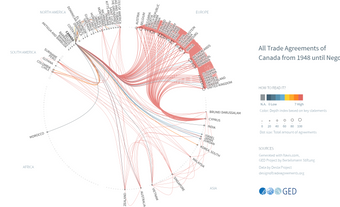Softwood Lumber Dispute
Softwood Lumber Dispute first arose in 1982 with a complaint by the US lumber industry that low Canadian stumpage rates constituted an unfair advantage. In Canada, provinces own most of the forest resource and administer the rates whereas in the US rates are set at an auction. The US Commerce Dept turned down the application for countervailing duties in 1983, but by 1985 the Canadian industry had captured more than one-third of the US market. In June 1985, US producers set up the Coalition for Fair Lumber Imports, lobbied Washington again and sought redress through the Int Trade Commission (ITC).
Negotiations between Canada and the US began in Jan 1986, with added pressure from US President Ronald Reagan, who promised to take action on the US producers' behalf if bilateral negotiations failed. On 19 May 1986 the Coalition filed a countervail petition seeking an import duty of 27%. On June 26 the ITC determined that Canadian policies had injured US producers. Meanwhile, Prem William VANDER ZALM of BC stunned the Canadian producers by declaring that stumpage rates were too low, in effect admitting the validity of the US complaint. In Sept, Trade Minister Pat CARNEY offered concessions amounting to a 10% increase. Meanwhile, the US Commerce Dept handed down a decision imposing a 15% duty. Canadians then undertook to avoid the duty by a "suspension agreement" by which the amount of any subsidy alleged by the US could be kept in Canada; however, the US would have considerable control over how the penalty would be imposed. BC and Québec supported the suspension. The result was an agreement, signed 30 Dec 1986, in which Canada agreed to impose a tax of 15% - amounting to $600 million a year - on Canadian softwood exports to the US. It was the largest self-imposed penalty in the history of world trade.
The case underscored the problems Canada faces in trade negotiations with the US (see FREE TRADE). Federal positions can easily undercut the provinces. Canadian producers argued that their success was the result of efficiency and good management, and that they were being victimized in the negotiations. Canadian reactions were a turmoil of fear at the American actions, outrage at the threat to Canadian sovereignty, and pessimism over the ability of federal representatives to negotiate in the face of provincial willingness to capitulate. In late 1987 the federal government reached agreements with BC and Québec whereby higher provincial stumpage charges were to be substituted for the 15% federal export tax on softwood lumber originating in these provinces.

 Share on Facebook
Share on Facebook Share on X
Share on X Share by Email
Share by Email Share on Google Classroom
Share on Google Classroom

